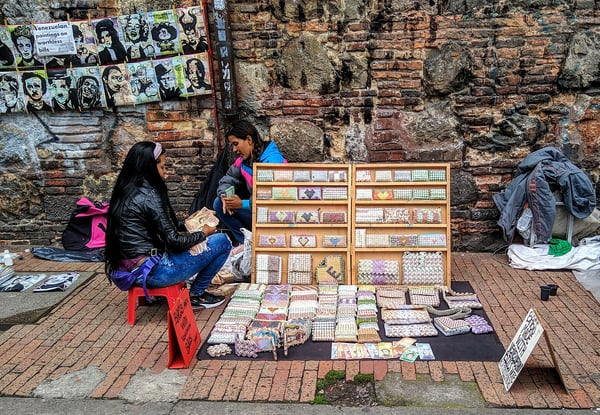People have differential experiences of forced migration because of intersecting power relations...


People have differential experiences of forced migration because of intersecting power relations...


In this edition of the forced migration video series, Professor Clark-Kazak discusses three key...

Christina Clark-Kazak researches forced migration policy in Canada and globally. She has served as...
Cripping Intersex: Exploring the Connection Between Disability and Intersex
Intersex and/as/is/with disability. The discursive, political, and embodied connections between disability and intersex deserve nuanced attention if we are going to strengthen intersex human rights claims and reflect the experiences of intersex people who live with the disabling consequences of medical intervention.
Formed at the juncture of a variety of disciplinary interests – disability, intersex, and queer studies, intersectionality, hauntology, sociology of medicine, feminist science studies, and bioethics – Cripping Intersex explores the undertheorized connection between intersex and disability and works to understand the contested meanings, responses to, and (haunting) effects of intersex traits, pathologization, queerness, and medical trauma.
Medical practitioners pathologize intersex traits – describe them as disabled, disordered, and diseased – and perform gratuitous interventions on intersex folks to maintain, what I term, compulsory dyadism: the instituted cultural mandate that people cannot violate the sacrosanct Western sex dyad or house the intersex “spectre.”
On the contrary, anti-interphobic advocates, including myself, condemn non-consensual intersex medical “treatment,” such as genital surgeries (also known as intersex genital mutilation), hormone replacement therapy, vaginal dilation, and so on. These interventions are supposedly curative. However, in a horribly ironic twist, in the effort to “cure” intersex people of their in-born intersex traits, these “curative” measures often result in a variety of short- and/or long-term disabilities: incontinence, anesthetic neurotoxicity, urethral strictures, chronic infection, genital pain, loss of sexual sensation or ability to orgasm, suicidal ideation, anxiety, depression, post-traumatic stress disorder, and so on.
Anti-interphobic advocates argue these interventions constitute genital mutilation, torture, and sexual abuse. Many also claim intersex traits are not disabled, disordered, diseased. I agree with the evaluation that these interventions are mutilation, torturous, abusive, and I add, disabling. However, I question if rejecting or distancing from disability is de facto good or productive.
I understand why one would want to distance from disability, disorder, or disease rhetoric. Doing so, one might assume, will resist the pathologization of intersex characteristics. However, I argue, this rejection of disability reproduces ableist logics and prevents intersex studies scholars and intersex activists from engaging with the invaluable tools offered by feminist disability studies such as, for example, astute analyses regarding how and why ableist rhetoric is mobilized within medical institutions. In this instance, ableist rhetoric presents intervention as a necessary good; it masks the fact that these interventions are performed to maintain compulsory dyadism as well as other forms of oppression.
To undermine compulsory dyadism and attain justice for intersex people, compulsory able-bodiedness must also be undermined. To elaborate, racism, queerphobia, sexism, and colonial logics used to be overtly mobilized to justify eradicating intersex traits, intersex eugenics, and demolishing Indigenous cultures and nations that did not – and do not – abide by the logics of compulsory dyadism.
Currently, medical professionals leverage ableist rhetoric to uphold compulsory dyadism. Ableism dominates because it is rarely recognized as a form of discrimination at all. So, if what intersex means hinges on what disability means, this full discriminatory complexity of pathologizing intersex variations must be attended to. Ultimately, I maintain, understandings of intersex must be cripped, destabilized. Failing to do so does a disservice to intersex, disabled, queer, and racialized people, chiefly intersex folks who have been disabled and are haunted by medical violence. Crip intersex studies and a crip intersex politics are needed.
Cripping Intersex analyses several sites of compulsory dyadism, such as medical rhetoric used to justify intersex “treatment,” medical and legal policies, sport sex testing, sport sex and dis/ability segregation, as well as reproductive technologies and intersex eugenics. While these sites may seem unrelated, they all shed light on the unique intersection of compulsory dyadism and compulsory able-bodiedness. Drawing attention to the connective (t)issue that holds these sites together – they are different manifestations of the same oppressive ideologies – reveals that disability and intersex are connected across multiple locations. Cripping Intersex, therefore, is unique because it situates various instances of interphobia alongside each other and offers the language – compulsory dyadism – to understand that these sites are interrelated, one in the same.
The publication of Cripping Intersex during October is timely. Intersex Awareness Day is fast approaching on 26 October. Engaging with intersex studies scholarship and activism as well as thinking of innovative ways to combat how and why intersex people are surveilled, violated, oppressed, and mutilated in the attempt to maintain compulsory dyadism – and all the systems of oppression that intersect with compulsory dyadism – are vital.
This interdisciplinary work will have broad appeal. Scholars and students of intersex, disability, women’s, gender, trans, and sexuality studies, medical sociology, bioethics, critical race theory, sport studies, medical and health rhetoric, and cultural studies will all find it very useful, as will activists and professionals working in intersex, disability, queer, and human rights fields.
By Celeste E. Orr
Celeste E. Orr is a Research Associate and Part-time Professor at the University of Ottawa and a Contract Instructor at Carleton University. Their research has been featured in Feminist Theory; From Band-Aids to Scalpels: Motherhood Experiences in/of Medicine; Boyhood Studies: An Interdisciplinary Journal; Mothering, Mothers, and Sport: Experiences, Representations, Resistances; and Connecting, Rethinking and Embracing Difference. Orr’s work will also soon be featured in Covid and…How to Do Rhetoric in a Pandemic and Surveillance & Society. Orr was a finalist for the Pierre Laberge Prize for Achievement in the Humanities.Also Read